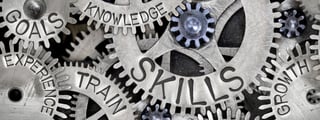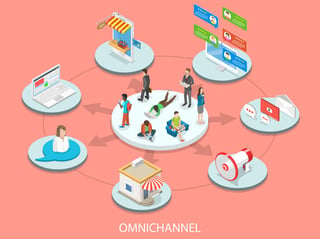Growth Insights for CEOs

Outsider Insights | From Hustle to System: Why More CEOs Are Rebuilding Their Sales Function
Outsider Insights
Across Chief Outsiders, we talk to hundreds of CEOs every month. In this new series, we explore the trends and challenges we’re hearing from these discussions – and what you can do if you’re facing the same issues in your business.
Recent Posts

CEO Growth Series: Challenge #1 - Lack of Focus
Wed, Jan 16, 2019 — Overcoming the most common impediment to business growth You can see it in their faces. The look of a tired or burned out entrepreneur with not enough time or resources to outrun the wave. Sound familiar? If you’re currently moving at 100 miles per hour and not accomplishing much, or you wonder if you are doing the right things, or you see lots of activity but not much in the way of results, you and your organization are probably suffering from a lack of focus. Lack of focus is the most common business problem standing in the way of growth and one of the hardest to resolve.

How Small- and Mid-sized Business (SMBs) Can Execute the “Virtuous Cycle” of Digital Growth
Thu, Dec 13, 2018 — This is the final installment in our series. This article will emphasize effective adoption of best practices, offer a logical sequence to implementation, and discuss building organizational and program maturity. This article will help you understand how to achieve “digital growth champion” status. This is also the last in a series of five articles focused on helping executives in small- and mid-sized businesses utilize digital technologies effectively to assist in accelerating revenues and profits. If you missed the first four articles, you can find them here: Article 1 Article 2 Article 3 Article 4

Aligning Business Strategies and Digital Platforms to Drive Growth in Small- and Mid-Sized Businesses (SMBs)
Thu, Dec 6, 2018 — This is the fourth in a series of articles focused on helping executives in small- and mid-sized businesses utilize digital technologies effectively to assist in accelerating revenues and profits. If you missed the first three articles, you can find the first here, the second here, and the third here. Three previous articles included an introduction to four major ways digital technologies can help your business and described a spectrum of technologies and a possible implementation roadmap, and associated digital proficiency with enhanced business performance. We also looked at how business process needs and priorities should help guide your digital paths and how to organize your people for success. We are ready to discuss the third step on the “USA” digital roadmap: “Implement New Platforms and Technology.”
Stay up-to-date with the latest from Chief Outsiders

Being Ferdinand Magellan: Four Key Predictive Indicators for Forecasting Your Growth Trajectory
Tue, Nov 27, 2018 — If you know the real story of the first man to successfully circumnavigate the earth, you know that Ferdinand Magellan died 16 months before his mission was completed. Despite his devastating death while in battle in the Philippines, his crew fearlessly sailed on without him – and completed his quest. They succeeded because Captain Magellan took the time to put the right KPIs in place – and his leadership team was deeply involved in the management, course predictions, and execution of the mission. Since they knew the predictable trajectory and the foreseeable obstacles before them, they were confident in carrying on to the finish line without their leader. As a CMO, I consider it my duty to provide navigable guidelines for those who are wondering what the best business growth metrics are for tracking, measurement, and forecasting. While Magellan’s guys didn’t exactly employ the same metrics as the ones I’m about to show you, it will be a good start in confidently sailing the challenging seas of your business marketplace.

What You Measure (And What You See) Is What You Get
Fri, Nov 16, 2018 — Are You Using Your KPIs Appropriately: Report Card or Predictive Data? After reading my first article in this series about using KPIs to properly predict the growth of your business, you likely began to understand why you should be wary of a simplistic view of KPIs in reporting company performance. Moreover, you may now fully realize the distinction between performance indicators and predictive indicators, which will help you uncover critical forecasts within your company data. As McKinsey explained in a recent article, “What gets measured, gets done.” That may be true, however, performance management begins to fail in any enterprise when executives use and act upon poor metrics, the wrong targets, or irrelevant information. How about an illustration? Let’s take a glance at a fictitious company example: New 3Q product sales at SparrowCo are up by 21 percent – and existing products sales are performing at the same steady level as last quarter, which was up 12 percent over 1Q. Business is clearly growing, would you agree? Everyone is happy, and the sales reps are counting commission dollars. Yay! Party time! But wait…there’s more! Let’s take a deeper look.

Maximize Your Growth Potential by Supercharging Your Learning Agility
Thu, Nov 15, 2018 — Imagine how much more money your company could make if you never made the same mistake twice. How much more successful would you be if you could quickly course correct every time a plan went awry? What new growth initiatives could you pursue with expanded capabilities? How much would your productivity increase if you could improve your ability to attract and retain top talent? Supercharging your company’s learning agility can drive material improvement in each of these areas. It will also enable your company to maximize its growth potential. Learning agility is the willingness and ability to learn from experience and insight, then leverage that learning to perform better. While companies have always needed to learn and adapt to be successful, changes in technology, consumer preferences, and political and economic forces make it difficult for them to keep their growth plans on course. Access to data and emerging technology has weakened industry barriers to entry, while simultaneously leveling the playing field for competitors. In today’s complex business environment, companies that learn and adapt will be the most successful.

Sales vs. Marketing: Chicken or Egg First?
Thu, Nov 15, 2018 — What comes first, adding a sales person or having ready prospects and opportunities to pursue? I once worked for a company where Sales held all the power – more than product development or finance and certainly more than marketing. I recall a discussion with a long-time senior executive about the amount of marketing investment required for the company to profitably grow. She commented that the company had a tried and true method of driving growth. “We don’t need to invest in marketing. For every sales person we add, then revenue will grow!”, she proudly exclaimed. This had indeed been true at one time in the company’s history, but along with that revenue growth came increased expenses and decreasing sales productivity. The company eventually went through an inevitable and painful exercise of downsizing a much too large sales force.

Omnichannel or Tunnel Vision?
Tue, Nov 6, 2018 — Journey with me back a few years, to a time when books were bought at a bookstore, clothing purchased at an apparel shop, and the concept of competitive shopping was limited to letting our fingers do the walking. Today, consumers are fully – and indelibly – in control. Selling our stuff to this finicky lot requires a trip to their dimension – or we risk them not hearing us. That’s why today’s CEO is being assaulted by entreaties to institute an omnichannel strategy as an essential piece of their competitive marketing plan.

Are You Using Your KPIs Appropriately: Report Card or Predictive Data?
Fri, Oct 19, 2018 — Just a few weeks ago, I enjoyed yet another screening of the 1976 movie The Gumball Rally. If you’ve never seen it, it’s a slapstick satire about a wild and crazy cross-country race. The competition starts in New York City, with a goal to finish in the shortest amount of time. During the trek, a driver named Franco rips the review mirror off his windshield and dramatically announces the first rule of Italian driving: “What’s behind me is not important!” Even though I’ve heard this line plenty of times, I couldn’t help but chuckle. This belief is not only applicable to the business world – but appropriate when creating and measuring your company’s Key Performance Indicators (KPIs). According to Investopedia, a KPI is a set of measurable data that a company uses to gauge its performance over time. Examples include return on marketing investment, customer lifetime value (LTV), and customer acquisition cost (CAC). There are endless performance indicators you can use to measure your business goals.
.png?width=1500&height=398&name=CO_Corporate%20Logo%202021_4C_HOR_FNL-1%20(1).png)